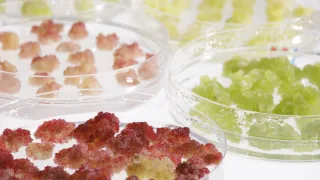VTT Technical Research Centre of Finland has used plant cell culture technology to develop new types of ingredients for the cosmetics industry. Cell cultures, which originated from birch leaves and seeds, produce pigments, as well as compounds that help to preserve products and inhibit the growth of harmful microbes. Cell culture technology is a natural and environmentally friendly production method.
Biotechnology-assisted production provides many advantages compared to using traditional plant materials. Plant-based compounds of consistently high quality can be produced for industrial use year-round, free of pollution and plant diseases.
Birch cell cultures can produce pigments – yellow carotenoids and red anthocyanins – as well as various amino acids important for the skin. They also produce essential fatty acids for humans, especially linoleic acid and alpha-linolenic acids, which play an important role in maintaining the skin's moisture and elasticity. The chemical composition of cultured cells is different from the actual plant, and compound production volumes can be influenced by different biotechnological processing methods.
Due to their composition, birch cell cultures have antioxidant properties that can improve the preservation of products and antimicrobial properties, which can influence the microflora of the skin by inhibiting the growth of harmful microbes. In the cell culture technology developed by VTT, LEDs can greatly increase the amount of red pigment, positively affect the antioxidative properties of cells and increase their antimicrobial activity.
"Cell cultures provide an opportunity to utilise wood material in a new way. By natural means, we can obtain compounds that have not traditionally been associated with birch, such as anthocyanin pigments which belong to the group of red polyphenols," says Riitta Puupponen-Pimiä, Principal Scientist at VTT.
Cell cultures also produce interesting polyphenols of a kind that are not found in birch. In general polyphenols are powerful antioxidants. These may prevent harmful oxidation reactions on the skin caused by so-called free radicals. In a product, they can also prevent fats from oxidation and thereby may provide a longer shelf-life.
Birch cell cultures were used in plant biotechnology research by VTT over 20 years ago. Since then, the cultures have been stored in liquid nitrogen in VTT Culture Collection. The idea of using birch cell cultures in cosmetics was launched in a project belonging to VTT's Innovative Business from Emerging Technologies Programme.
VTT Culture Collection: http://culturecollection.vtt.fi/
MEDIA MATERIAL:
PHOTO: The birch cell culture grown by VTT produces high levels of anthocyanins, which give the cell mass a red colour. VTT grew three different cell lines in its experiments: two red and one green.



